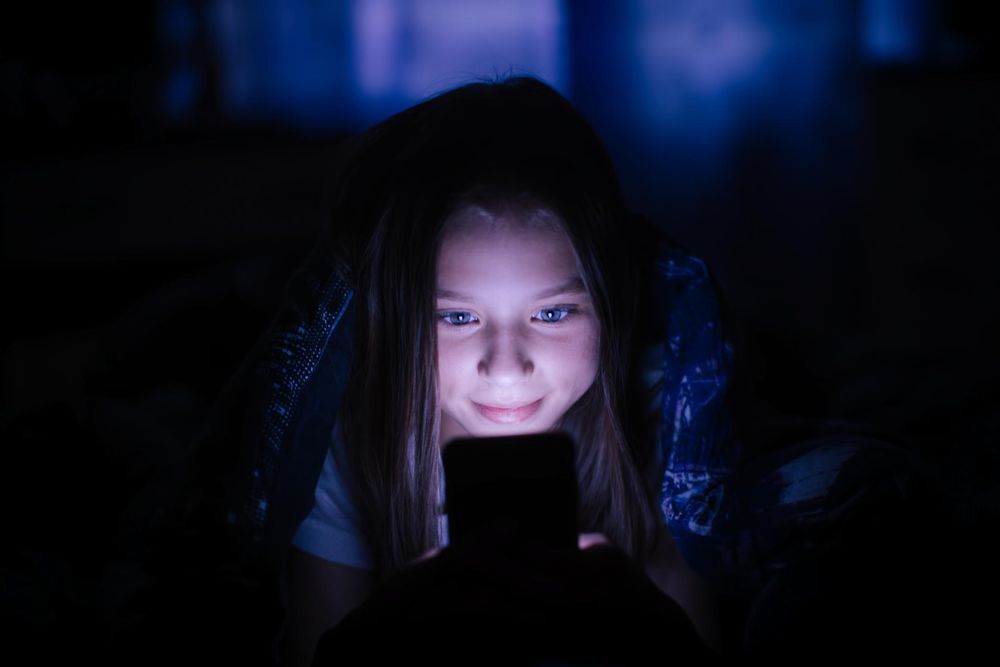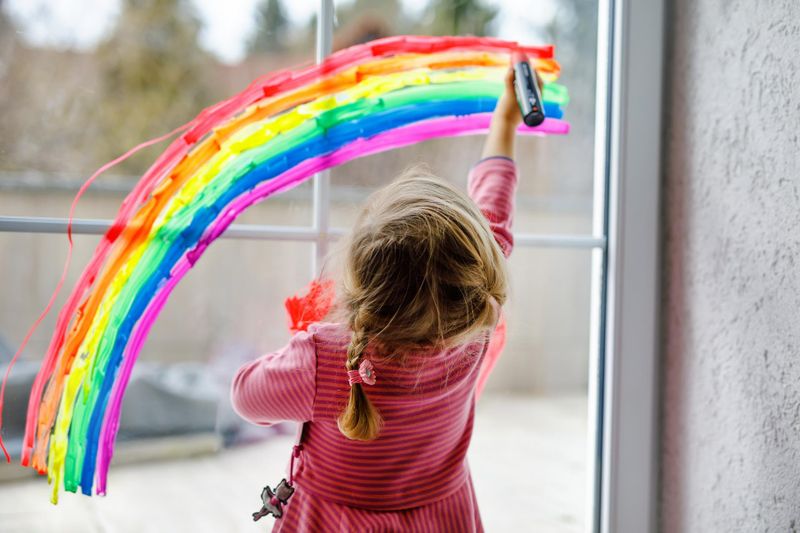DIGITAL WELLBEING
9 Ways to Protect Your Kid from Blue Light
Did you know that the glow from your kid's screen might be stealing more than just their attention? Discover how blue light could be silently affecting your kid's sleep and explore 9 proven strategies to ensure a good night's sleep for your little one - and yourself.

Digital devices like smartphones and tablets have profoundly changed our daily lives, and particularly those of our kids. While these devices offer benefits for learning and entertainment, they also come with a less known side-effect: the emission of blue light.
What Exactly is Blue Light?
Picture the spectrum of visible light as the familiar rainbow we know, starting from red and ending in violet. This isn't just a shift in color, but also a progression in energy levels. Blue light, with its shorter wavelength, occupies a position near the violet end, signifying its higher energy intensity. Think of blue light as the energetic toddler of the light spectrum – always on the go!

Blue light has a short wavelength and is full of energy. (Source: Shutterstock)
Now, you might wonder, where does this blue light come from? Everywhere! Be it your kid's screen, a regular light bulb, or the sun - any source of light emits blue light waves, both artificial and natural. In fact, have you ever admired a clear blue sky on a sunny day? That's blue light at work.
Is Blue Light Harmful?
Blue light isn't the villain. It's the timing that's the issue. During the day, blue light acts like a shot of espresso served by nature. We get our primary dose of blue light from the sun, ramping up our body temperature and heart rate, which boosts alertness, helps memory and cognitive function, and elevates mood.
Historically, humans wouldn't encounter blue light once night fell. But in our modern world, we aren't left in darkness after the sun sets: many artificial lights, particularly LEDs in our screens, keep us illuminated and emit a significant amount of blue light.
And it's exactly the blue light after dark that can mess with our sleep.
How Screens Impact Our Sleep
Blue light has a unique influence on our body's internal biological clock, also known as the circadian rhythm. This rhythm runs a tight 24-hour schedule and relies on light cues, which is why we stay awake during the day and sleep during the night. While all visible light influences our circadian rhythm, blue light wields the most power in this regard.
The challenge arises with exposure to screen-generated blue light after sunset. To our body, blue light mimics daylight. When screens flood our eyes with blue light in the evening, it can trick our brain into believing it's still daytime, confusing our sleep-wake cycle. The consequence? A disruption in the release of melatonin, a hormone our body produces to make us sleepy.
Studies highlight that pre-bed screen activities—whether it's TV, gaming, or browsing on devices—might result in reduced sleep duration and more disruptions throughout the night. Yet, it's worth noting that while blue light can sabotage our sleep, the American Academy of Ophthalmology finds no conclusive evidence of it physically harming our eyes.
Young Eyes, Higher Stakes
As we age, our eyes become less light-sensitive. Kids are more susceptible to blue light because they have larger pupils and clearer lenses. Research indicates that evening light exposure suppresses melatonin production twice as much in kids as compared to adults. And younger kids, especially pre-puberty, are even more sensitive.
The result? Besides the immediate sleep disruptions or insomnia, there's an added risk of fatigue, academic challenges, mood swings, and even health concerns like obesity. Couple this with the fact that their brains are still developing, and the emphasis on sound sleep becomes clear.
Effective Strategies to Protect Your Kid's Sleep
Thankfully, as with all challenges, there are solutions. Here are 9 ways to minimize the impact of blue light on your kid's sleep.
1. Create a Digital Curfew
Allocating a 'screen-free' period before bedtime is one of the most effective ways to combat blue light's effects. Aim for at least an hour of no screen use before your kid drifts off to dreamland. This allows your kid's body to naturally ramp up melatonin production, preparing them for a restful night.
With Ohana, enforcing this digital curfew becomes a breeze. Ohana allows you to set a specific bedtime schedule, defining when your kid’s device should automatically lock for the night. This promotes discipline and a healthy sleep routine.
2. Use that Tech
Most digital devices come equipped with a blue light filter. This feature changes the color temperature of the screen from blue to a yellowish and warmer hue, effectively reducing blue light emission. Activate this feature and set it to turn on automatically at sunset, or at least 2-3 hours before their bedtime. This small step can make a significant difference.
Quick guide on how you turn on the Night Shift feature on your kid's iOS device:
- Go to the Settings.
- Tap on Display & Brightness.
- Activate Night Shift.
- Schedule it and set the color temperature to More Warm.
If your kid’s Android device lacks this in-built feature, consider using free apps like Twilight, Blue Light Filter – Night Mode, or Night Shift: Blue Light Filter.
3. Establish Tech-Free Bedrooms
Creating a tech-free bedroom helps nurture healthy sleep habits. Encourage your kid to leave their devices outside the room before they start their bedtime routine. Keeping screens out of the bedroom not only limits blue light exposure, but also prevents sleep interruptions from notifications, messages, or alerts.
4. Equip with Blue Light Blockers
If screens are an indispensable part of your kid's evening, blue light glasses might be a worthy addition to their toolkit. These special glasses are designed with lenses that filter out the blue light, considerably reducing its impact. Do note, while they do prevent blue light from messing with your kid's sleep patterns, there's no conclusive research indicating they alleviate digital eye strain.
5. Encourage Regular Exercise
Exercise does wonders for sleep quality. By ensuring your kid engages in physical activity during the day, they're more likely to sleep soundly. Just remember: high-energy activities should wrap up a few hours before bedtime to avoid overstimulation.

Being outdoors lifts your kid's spirits and helps them sleep better. (Source: Shutterstock)
6. Prioritize Daylight Exposure
Nature's own blue light, the sun, benefits our circadian rhythm. By soaking up some sun, your kid’s internal clock aligns better with natural day-night cycles, facilitating restful sleep come nighttime.
7. Educate and Empower
One of the most empowering strategies is to educate your kid about the impact of blue light. Make them aware of how their screens could interfere with their sleep and well-being. Encourage them to make mindful choices about their screen time and device settings. When they understand the why behind your rules, they're more likely to follow them.
8. Promote Screen-Free Relaxation
Pre-bedtime should be all about relaxation. Swap out screens with calming activities that help your kid wind down and set the stage for better sleep. This can include reading a book (preferably a physical one), listening to calm music or audiobooks, or playing with non-digital toys. Or let them explore their creativity through drawing or writing. For older kids, introduce mindfulness exercises, like deep breathing or light yoga, which can help ease the transition into sleep.
9. Lead By Example
Children mirror adults, and our actions often speak louder than our words. When we prioritize sleep and make conscious choices about screen time, our kids are more likely to do the same. So embody these tips and the balance you wish to see in your kid's routine, and you'll likely find them following suit.
Digital devices are here to stay, and so is the blue light they emit. However, by understanding its effects and using effective strategies, we can minimize its impact on our kids' sleep. Encouraging healthy digital habits now can pave the way for a lifetime of good sleep and overall well-being for your kid.